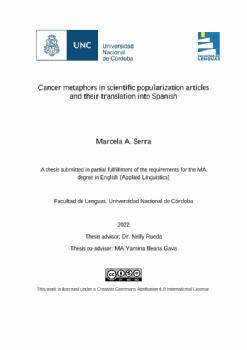| dc.contributor | Gava, Yamina Ileana | |
| dc.contributor.advisor | Rueda, Nelly | |
| dc.contributor.author | Serra, Marcela A. | |
| dc.date.accessioned | 2022-11-22T14:24:08Z | |
| dc.date.available | 2022-11-22T14:24:08Z | |
| dc.date.issued | 2022 | |
| dc.identifier.uri | http://hdl.handle.net/11086/29743 | |
| dc.description | A thesis submitted in partial fulfillment of the requirements for the MA degree in English (Applied Linguistics) | |
| dc.description.abstract | Capitalizing on the insights from Conceptual Metaphor Theory and a growing number of
studies on the role of metaphor in the health sciences, this study explores cancer
metaphors in a corpus of 6 English scientific popularization articles published by the New
York Times and Scientific American and their corresponding translations into Spanish.
Framed within a cognitive-discursive approach, a descriptive-contrastive methodology
was applied to examine metaphor patterns used to talk about cancer and immunotherapy
and explore their Spanish translations. Metaphorical expressions (MEs) in the English
corpus were identified, described and quantified. In line with previous studies, Violence
MEs of the prototypical warfare variety were found to be recurrently used to
conceptualize the cancer-patient relationship and to explain the workings of
immunotherapy. Mechanicist metaphors were also recurrent to explain the functioning of
the immune system and depict cancer scientists’ actions. Other comparatively less
recurrent patterns were also identified. The analysis went beyond the description of the
linguistic form and considered the textual, discursive, rhetorical and cognitive functioning
of metaphors. Their textual function proved to be of great importance for translation. MEs
were observed to occur in chains and construct image-rich scenarios serving a rhetorical
intensifying function and lending cohesion to the text. Special consideration was given to
their cognitive functioning as the prevailing metaphorical frames reveal an antagonistic
conceptualization of health and disease that may influence lay audiences’ thinking and
acting concerning cancer. Second, the analysis concentrated on Spanish translations.
Similarities and differences as to conceptual domains and local and global effects were
observed. Results indicate that MEs are at times simply dropped or substituted with nonmetaphorical material. Even in cases of retention, the actual MEs chosen in Spanish are
often less image-rich and less specific than the English ones. Micro level choices were
examined and found to be significant for they produce different ideational and discursive
effects. The overall results suggest metaphors must not be considered as an individual
linguistic phenomenon as they do not occur in isolated, unconnected and sporadic form
but rather in a patterned way. In order to employ MEs that bring about the same local and
global effects, translators need to be aware of metaphors’ essential multifunctionality and
their contribution to textual connectedness | es |
| dc.language.iso | eng | es |
| dc.rights | Attribution-NonCommercial-NoDerivatives 4.0 Internacional | * |
| dc.rights.uri | http://creativecommons.org/licenses/by-nc-nd/4.0/ | * |
| dc.subject | Metaphor Theory | es |
| dc.subject | Artículos científicos | es |
| dc.subject | Scientific articles | es |
| dc.subject | New York Times | es |
| dc.subject | Scientific American | es |
| dc.title | Cancer metaphors in scientific popularization articles and their translation into Spanish | es |
| dc.type | masterThesis | es |
| dc.description.fil | Fil: Serra, Marcela A. Universidad Nacional de Córdoba. Facultad de Lenguas; Argentina. | es |






